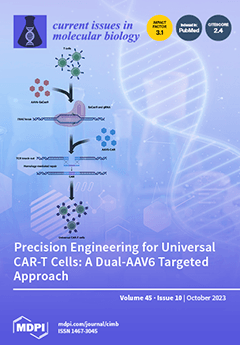
Journal Menu
► ▼ Journal MenuJournal Browser
► ▼ Journal Browser-
arrow_forward_ios
Forthcoming issue
arrow_forward_ios Current issue - Volumes not published by MDPI
- Vol. 42 (2021)
- Vol. 41 (2021)
- Vol. 40 (2021)
- Vol. 39 (2020)
- Vol. 38 (2020)
- Vol. 37 (2020)
- Vol. 36 (2020)
- Vol. 35 (2020)
- Vol. 34 (2019)
- Vol. 33 (2019)
- Vol. 32 (2019)
- Vol. 31 (2019)
- Vol. 30 (2019)
- Vol. 29 (2018)
- Vol. 28 (2018)
- Vol. 27 (2018)
- Vol. 26 (2018)
- Vol. 25 (2018)
- Vol. 24 (2017)
- Vol. 23 (2017)
- Vol. 22 (2017)
- Vol. 21 (2017)
- Vol. 20 (2016)
- Vol. 19 (2016)
- Vol. 18 (2016)
- Vol. 17 (2015)
- Vol. 16 (2014)
- Vol. 15 (2013)
- Vol. 14 (2012)
- Vol. 13 (2011)
- Vol. 12 (2010)
- Vol. 11 (2009)
- Vol. 10 (2008)
- Vol. 9 (2007)
- Vol. 8 (2006)
- Vol. 7 (2005)
- Vol. 6 (2004)
- Vol. 5 (2003)
- Vol. 4 (2002)
- Vol. 3 (2001)
- Vol. 2 (2000)
- Vol. 1 (1999)
Need Help?
Curr. Issues Mol. Biol., Volume 45, Issue 10 (October 2023) – 53 articles
Cover Story (view full-size image):
In this study, the researchers utilized AAV6-mediated dual transduction to precisely integrate an anti-CD19 CAR into human T cells at a specific genomic location. They employed two viral vectors, one expressing Cas9 endonuclease and a guide RNA targeting the T-cell receptor alpha constant locus, while the other carried the DNA template for CAR insertion. The molecular analysis results confirmed the targeted integration of the CAR transgene into the desired genomic location, offering a promising alternative to the conventional random integration methods for CAR T cell generation. This method not only reduces the risk of insertional mutagenesis, but also knocks out the endogenous T-cell receptor, enabling the use of allogeneic donor cells and potentially paving the way for "off-the-shelf" universal CAR-T cell immunotherapies, thus simplifying production and administration. View this paper
- Issues are regarded as officially published after their release is announced to the table of contents alert mailing list.
- You may sign up for e-mail alerts to receive table of contents of newly released issues.
- PDF is the official format for papers published in both, html and pdf forms. To view the papers in pdf format, click on the "PDF Full-text" link, and use the free Adobe Reader to open them.
Previous Issue
Next Issue
Issue View Metrics
Multiple requests from the same IP address are counted as one view.





